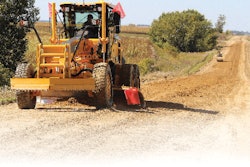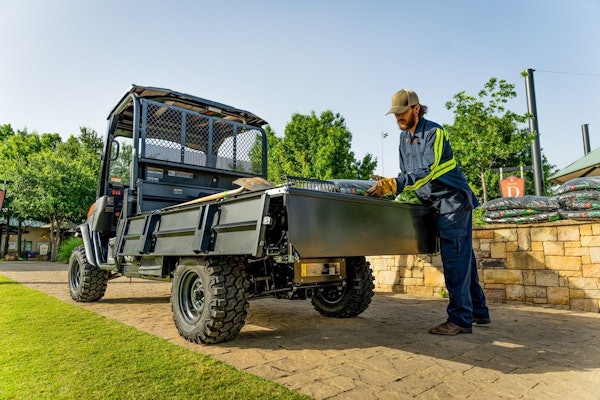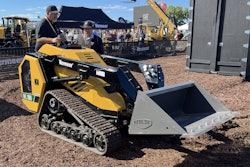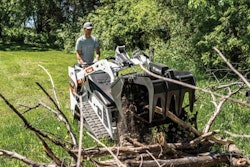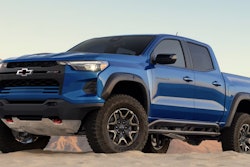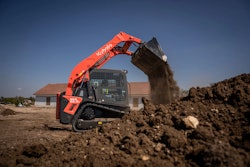Diamond grooving and grinding are being used to restore rough or polished concrete pavements to ultrasmooth conditions and quell noise – but at a price.
By Tom Kuennen, Contributing Editor
Diamond grooving and grinding of aging portland cement concrete (PCC) pavement renews the pavement, providing a smoother-riding surface while enhancing skid-resistance and reducing pavement noise, experience and research shows.
As PCC can be somewhat rough following placement, grooving and grinding also can be applied to virgin PCC pavements to improve IRI smoothness numbers before they’re open to traffic.
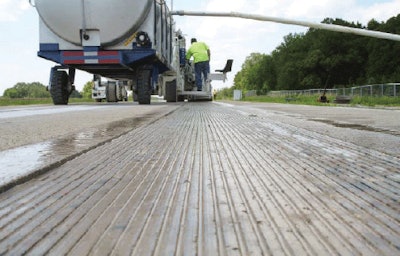 Next Generation Concrete Surface (NGCS) describes a category of grooved textures for both new construction and rehabilitation that reduce pavement noise and improve smoothness.
Next Generation Concrete Surface (NGCS) describes a category of grooved textures for both new construction and rehabilitation that reduce pavement noise and improve smoothness.And the resulting smoother profile reduces dynamic loading on the pavement, thus extending its service life, according to the International Grooving & Grinding Association (IGGA), so grooving and grinding – as does surface texturing, by use of mobile shot blast equipment – fit into today’s movement of pavement preservation.
Grooving and grinding have been identified as essential parts of the Next Generation Concrete Surface (NGCS), as articulated in 2009. This term describes a category of grooved textures for both new construction and rehabilitation that reduce pavement noise and improve smoothness.
However, it all can come at a steep price: Diamond grinding, grooving and shotblasting require expensive, self-propelled specialty equipment, and usually is executed by a subcontractor with equipment and crews. In some instances, as in Florida, grinding of new PCC pavements is required by state Department of Transportation (DOT) regulations, so the cost is built into the overall project price.
Grooving, grinding and preservation
Diamond grooving and grinding is a concrete pavement preservation technique that corrects a variety of surface imperfections on concrete pavements, and may be used in conjunction with other pavement preservation techniques, reports IGGA.
It involves the removal of a thin layer of the cured concrete surface using a dedicated, self-propelled machine with closely-spaced diamond-coated circular saw blades. Diamond grinding restores rideability by removing surface irregularities. The immediate effect of diamond grinding is a significant improvement in the smoothness of a pavement, and a substantial increase in surface macrotexture with improvement in skid resistance, noise reduction and safety.
Grooving and grinding – and associated concrete pavement restoration techniques – are elements of the pavement preservation “tool box” used by government agencies to prolong pavement life. For example, pavement preservation has been a part of the Minnesota Road Research Project (MnROAD) test facility north of Minneapolis since it first opened in 1994, and grooving and grinding have been part of it.
The two MnROAD road segments are a 3.5-mile, two-lane interstate mainline carrying live I-94 traffic, averaging 26,500 vehicles per day with 13 percent trucks for the westbound lanes; and a 2-1/2-mile, two-lane closed loop low volume road. Traffic on the low-volume, closed loop is restricted to a MnROAD 18-wheel, five-axle, tractor/trailer which averages 70 laps a day. (For “Minnesota’s New Solutions for Aging Pavement,” go to betterroads.com/minnesotas-new-solutions-for-aging-pavement.)
Materials tested include asphalt and concrete; regarding the latter, MnROAD has completed tests involving bonded and unbonded concrete overlays, concrete partial depth repairs, full-depth joint repairs, and PCC diamond grinding.
Recent innovations in diamond grinding techniques are a result of tests at the MnROAD facility. Working through a pooled fund study, several diamond grinding configurations first developed at Purdue University were field-tested on the low-volume road in 2007. MnROAD staff since has been monitoring them to determine their long term performance with regards to noise, texture and friction. The successful performance of these textures at MnROAD has led to their implementation in several projects in Minnesota and other states.
Preserving Nashville’s I-440
Grooving and grinding helped preserve I-440 from I-40 East to I-40 West in Nashville. The heavily used, existing pavement had experienced faulting, spalled joints, some random cracking and there was a need to address skid resistance.
After having first considered 4-inch asphalt concrete resurfacing and shot blasting as options to renew the texture, Tennessee DOT decided to use concrete pavement preservation, including full-depth slab replacement, as its rehabilitation method.
The project included 10,000 square yards of pavement replacement, 2,000 square yards of spall repair, 350,000 square yards of diamond grinding and grooving, and 450,000 linear feet of joint cleaning and resealing.
Working around the multitude of sporting events in the area, the state incorporated full weekend closures to accelerate the construction progress. As the highway is so heavily traveled, work was performed at night to avoid the congestion problems caused by the high-traffic volumes during the day. Further, the team performed longitudinal grooving to enhance safety.
“This project grew in scope after traffic was diverted and we had the opportunity to perform a closer inspection of pavement,” said Doug Hagar, project engineer for the Tennessee DOT. “But by completing all the necessary repairs while the contractor was on site, Tennessee road users can expect many years of smooth, uninterrupted service.”
With a project value of $4.3 million, the final cost of the treatments – including dowel bar retrofit, diamond grinding and full-depth slab replacement – was about $400,000 per mile. Further, this preservation project resulted in a smoother riding surface and improved skid resistance, which not only increased the aesthetic appeal but made the roadway safer for travelers.
“We now have a smoother, safer roadway for travelers,” said Jay Norris, special projects engineer for the Tennessee DOT. Team members included Tennessee DOT, LoJac Inc. (prime contractor), Penhall Company (grinding), and Truline Coring & Cutting (sawing).
Diamond grind smoother than SMA?
Diamond-ground portland cement concrete can be smoother than stone matrix asphalt (SMA), as was demonstrated by high-speed profile testing of adjacent sections on I-290, the Eisenhower Expressway (a.k.a. the “Ike”), on Chicago’s West Side.
Recently, Ames Engineering of Ames, Iowa, conducted profile testing of three lanes in both directions of I-290 between Austin Avenue and Sacramento Boulevard. The profile testing was conducted to compare the SMA ride qualities with those of the conventional diamond-ground pavement.
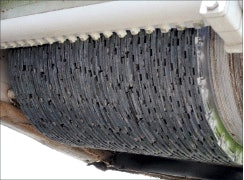 Closely spaced diamond-coated circular saw blades are at the heart of this self-propelled grooving/grinding machine.
Closely spaced diamond-coated circular saw blades are at the heart of this self-propelled grooving/grinding machine.That’s because a year earlier, on this section of roadway, both a stone matrix asphalt overlay and a conventional diamond-ground surface were constructed. The project, which extended for approximately 3.8 miles, consisted of overlay of three to four lanes of the existing plain-jointed portland cement concrete pavement roadway in each direction with SMA from Austin Avenue to Kostner Avenue, and from Homan Avenue to Sacramento Boulevard.
The conventional diamond grinding was used to retexture the existing continuous reinforced concrete pavement between Kostner and Homan avenues. This diamond grinding was done by a joint venture of Quality Saw and Seal Inc., and Safety Grooving and Grinding.
Shortly after completion of the diamond grinding, the project was evaluated for tire/pavement noise using an on-board sound intensity noise measurement device. The diamond-ground and SMA surfaces were comparable in noise level, with the diamond-ground registering at 103.7 dBA and the SMA at 103.4 dBA. (For the article, “IGGA: Agencies specifying diamond saw-cut textures to solve smoothness, noise and safety issues,” in Better Roads, go to betterroads.com/igga-agencies-specifying-diamond-saw-cut-textures-to-solve-smoothness-noise-and-safety-issues.)
The diamond grinding on this project received an award for its ride quality, which prompted IGGA to conduct profile testing of both the SMA and diamond-ground surfaces to compare ride characteristics.
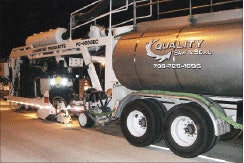 Ames Engineering of Ames, Iowa, conducted profile testing of three lanes in both directions of Chicago’s I-290, the Eisenhower Expressway, between Austin Avenue and Sacramento Boulevard after diamond grinding (as shown here) was done in 2010. The profile testing was conducted to compare the stone matrix asphalt ride qualities with those of the conventional diamond-ground pavement.
Ames Engineering of Ames, Iowa, conducted profile testing of three lanes in both directions of Chicago’s I-290, the Eisenhower Expressway, between Austin Avenue and Sacramento Boulevard after diamond grinding (as shown here) was done in 2010. The profile testing was conducted to compare the stone matrix asphalt ride qualities with those of the conventional diamond-ground pavement.The Ames Engineering profile van measured the profile in each wheel path simultaneously. Two RoLine sensors were mounted on a cross member which attaches to the front bumper, positioned 12 inches above the pavement, and simultaneously the RoLine footprints were positioned 72 inches apart (center-to-center).
At the same time that profile measurements were obtained, still photos were taken at approximate 150-foot intervals, allowing correlation between the profile results and a roadway image. The image was captured using a camera mounted to the windshield just below the rear view mirror. Both the images and profile data were linked to GPS coordinates.
The research found that the diamond-ground surface had an overall average profile index (zero blanking band) of 20 inch/mile with a standard deviation of 3.9 inch/mile, while the SMA exhibited an overall average of 23.1 inch/mile and a standard deviation of 6.3 inch/mile. While 90 percent of the diamond-ground surface exhibited a profile index of 25 inch/mile or less, only 61 percent of the SMA surface achieved this. Additionally, while 100 percent of the diamond-ground surface can meet a requirement of 30 inch/mile, 10 percent of the SMA surface still would exceed this limit.
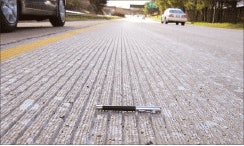 I-440 concrete pavement preservation project near Nashville included 350,000 square yards of diamond grinding and grooving.
I-440 concrete pavement preservation project near Nashville included 350,000 square yards of diamond grinding and grooving.The results indicate that the diamond-ground surface was smoother than the SMA overlay by approximately 3 in./mile, and that the smoothness variability was approximately half that of the SMA surface. (For “Profilometer Testing on Chicago’s I-290: Stone matrix asphalt overlay vs. conventional diamond grinding,” that ran in Better Roads, go to betterroads.com/profilometer-testing-on-chicagos-i-290-stone-matrix-asphalt-overlay-vs-conventional-diamond-grinding.) a result of tests at the MnROAD facility. Working through a pooled fund study, several diamond grinding configurations first developed at Purdue University were field-tested on the low-volume road in 2007. MnROAD staff since has been monitoring them to determine their long term performance with regards to noise, texture and friction. The successful performance of these textures at MnROAD has led to their implementation in several projects in Minnesota and other states.
What is Next Generation Concrete Surface?
The NGCS is an innovative grooving/grinding technique that provides a long-lasting, noise-reducing surface texture for concrete pavement.
“[NGCS] is a diamond saw-cut surface designed to provide a consistent profile absent of positive or upward texture, resulting in a uniform land profile design with a predominantly negative texture,” IGGA says in its tech brief, Next Generation Concrete Surface. “Conventional diamond-ground surfaces produce a positive or upward texture, although they are still quieter than most other concrete pavement surface textures.”
Thus the NGCS is predominantly a level (land) surface with grooves, in different configurations for different end results, rather than a surface with closely spaced parallel ridges featuring irregular “fins.”
“The texture is most easily constructed in a two-pass operation using diamond-tipped saw blades mounted on conventional diamond grinding and grooving equipment,” IGGA says. “Testing has shown that these textures can be used for both new construction and rehabilitation of existing surfaces.”
Refinement of the NGCS continues. At the January 2014 Transportation Research Board (TRB) meeting in Washington, D.C., researchers described an automated groove identification and measurement methodology that can reliably judge surface/groove conditions as the NGCS ages.
“Since the grooved texture may deteriorate over time, the measurement of groove dimensions becomes an indispensable tool for NGCS’s long term performance evaluation,” say Kelvin C. P. Wang, Lin Li, Qiang Joshua Li, and Paul Tikalsky, P.E., Oklahoma State University-Stillwater, and Larry Scofield, P.E., IGGA, in their peer-reviewed paper, Automated Groove Identification and Measurement for Next Generation Concrete Surface (NGCS) Using 3D Pavement Data at 1mm Resolution.
“The NGCS surface is the new non-porous concrete texture introduced in the last 20 to 30 years, which is a hybrid texture that resembles a combination of diamond grinding and longitudinal grooving for concrete pavement,” the authors say. “Since October of 2007, there are 17 surfaces in 10 states in which evaluation of its performance is ongoing. Some of the NGCS sections are monitored to evaluate their effectiveness in noise reduction and safety improvement over time. The presence of the downward or negative texture can decrease tire-pavement noise by 6 dBA, which is equivalent to 75 percent of noise reduction.”
Traditional point laser-based profiling system is used to measure pavement transverse grooves, the authors write. “However, this technique is incapable of evaluating longitudinal grooves that are used in NGCS,” they say. Alternatively, they propose an automated groove identification and measurement methodology for NGCS using 1mm resolution 3D pavement surface data collected from the recently developed PaveVision3D Ultra System.
“A template-matched groove identification algorithm is proposed to detect and identify the longitudinal grooves for NGCS,” they say. “Subsequently, the groove dimensions are estimated based on an established procedure. Comparing the constructed NGCS groove dimensions with the estimated dimensions derived from this research, it is demonstrated that the proposed algorithm is robust in detecting longitudinal NGCS grooves and estimating their dimensions. Further research is anticipated to investigate the groove dimensions on NGCS’s noise level and safety performance over time.”
Read about shot blast texturing at betterroads.com/shot-blast-texturing.




